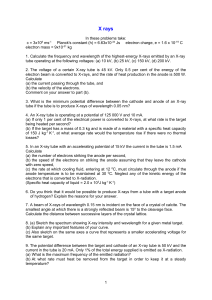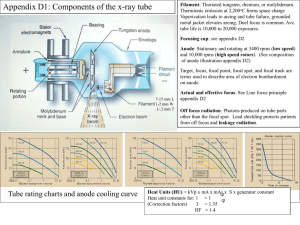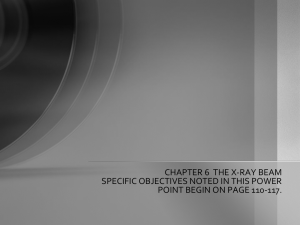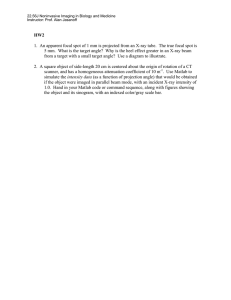The X-ray Tube
advertisement
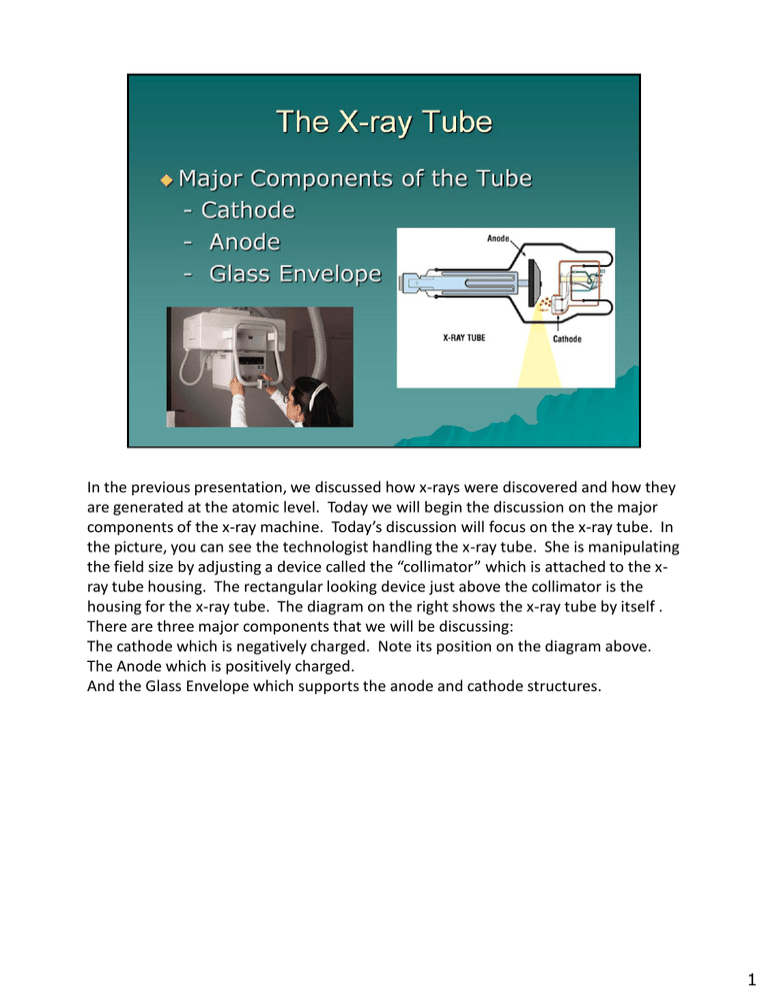
In the previous presentation, we discussed how x-rays were discovered and how they are generated at the atomic level. Today we will begin the discussion on the major components of the x-ray machine. Today’s discussion will focus on the x-ray tube. In the picture, you can see the technologist handling the x-ray tube. She is manipulating the field size by adjusting a device called the “collimator” which is attached to the xray tube housing. The rectangular looking device just above the collimator is the housing for the x-ray tube. The diagram on the right shows the x-ray tube by itself . There are three major components that we will be discussing: The cathode which is negatively charged. Note its position on the diagram above. The Anode which is positively charged. And the Glass Envelope which supports the anode and cathode structures. 1 As indicated in the previous slide, the cathode structure is electrically negative. This is negative because it is a source of electrons. Note that the diagram shows a magnified view of the cathode face and it shows dual filaments. Only one filament at a time will work. The small filament is designed to be used with relatively small parts while the large filament is used when larger body parts are being x-rayed. The structure which supports the filaments is known as the “focusing cup”. It is designed and shaped so that when the x-ray machine is powered up, electrons will literally “boil” off the filament. It glows white hot and the electrons hover around the filament in a “space charge” until the moment of exposure and then they accelerate very rapidly towards the anode which is not very far away. This process is known as “thermionic emission”. Thermionic emission occurs when the technologist begins to make an exposure by pressing the “ready” button on the machine. This action initiates the “boost phase” or that part of the exposure process where the x-ray tube is being prepared for the exposure to take place. While you cannot see the actual shape of the focusing cup, it is designed such that it helps “concentrate” the electron stream in a pre-determined area on the Anode target area known as a “focal spot”. The filament has its own circuit powered by a relatively low voltage and 4 – 6 amperes. 2 In this slide, we have two examples of how electrons can function given two different conditions. In the model on top, you will see that because electrons repulse each other, as soon as they leave the structure, the electrons tend to spread out. This would not be conducive to good x-ray production. The spread of the electrons occurred because the focusing cup is not negatively charged. In the second model, you will notice that the cathode structure is negatively charged. This charge then forces the electrons together as they exit the cathode structure thereby ensuring that the electrons stream does strike the focal spot in a relatively small area. 3 This slide shows how a non-functioning focusing cup would result in a wide spray pattern of electrons. This would result in xrays being generated in a wide area rather than in a small focal spot which is essential for clear images. 4 With this slide, you can clearly see that the distance between the cathode and the rotating anode disc is very close. This is designed this way to ensure that the projectile electron stream has a reasonably good chance of arriving at the anode in a relatively tight pattern. If the electrons were premitted to spread out, then the x-ray production process would become very inefficient. 5 These diagrams demonstrate two operating conditions which influence the x-ray production process. Please note that the number of electrons that are released will directly influence the number of x-rays that are generated and therefore the dose of radiation also. While these diagrams show just a few electrons, the reality is that there are countless billions of electrons that are typically released during any exposure. This diagram shows how a low mA will result in fewer x-rays being produced and a high mA will result in a greater number of x-rays. The term mA is a unit of measure of electrical current that is used when the technologist selects the exposure factors. mA is one of four “Prime Exposure Factors” we will be discussing soon. 6 In summary,the cathode structure, contains the filament and the focusing cup. The purpose for the filament cut is to guide the electron stream to the target area on the anode. Because of the tremendous amount of heat that is generated at the cathode, the structure is made of molybdenum nickel alloy which has excellent thermal qualities. 7 The technologist has the responsibility of choosing which filament to use with any given procedure. The technologist automatically selects the filament of choice when the “focal spot size” is chosen. As previously mentioned, the focal spot size that is selected is based on the relative size of the part that is to be x-rayed. In general, large body parts will require the selection of the large focal spot setting and small parts, require the small focal spot. 8 The 2nd major part of the x-ray tube is the Anode. The anode has a positive electrical charge and attracts electrons when the exposure button is pressed. The anode is actually a disc made of Tungsten because of its thermal qualities also. The disc is designed to rotate during operation. Recall how the cathode is positioned in relation to the anode and you can see that the electron stream will strike at the lower part of the disc along an area called the “focal track”. It is called a track because the anode rotates very fast and the idea is for the electrons to not concentrate on any given spot for any length of time. Rotation “spreads” the build-up of heat along the entire disc rather than just one given spot. The specific spot along the track where the electron stream strikes is called the “focal spot” or tube focus. The focal spot settings available are “large” and “small”. Example sizes are 2.0 millimeters square for the large size and 1.0 millimeter square for the small size. As you recall from the arrangment of the filaments, the small filament directs its electron stream to the small focus while using the large filament, directs the stream over the larger focal spot. The small focal spot is superimposed over the large one. 9 This diagram demonstrates the relative position of the anode and cathode and the resulting emission of x-rays. Note that the anode is attached to a cylindrical part known as the “rotor”. The rotor is actually part of a motor that is made to rotate at very high speed. In most x-ray tubes, the revolutions per minute is usually at 3,200 for standard technique settings, however if the technologist selects exposure factors that are considerably larger and therefore very hot, then the rotor can rotate at a much greater speed exceeding 5,000 rpm. The rotation of the anode ensures that not any one spot will receive successive pulses of electrons. If there was no rotation, then it is very likely that the anode face would be damaged due to high heat. 10 This photo shows the face of an anode. In this model, it shows considerable wear along the “focal track” . Typically, when an xray tube is new, the anode face is very shiny and smooth, however as time goes on, the wear begins as a result of the tremendous heat produced when the electrons strike the anode. The face becomes worn and rough and may eventually fail or crack. To increase the durability of the disc, it is comprised of molybdenum with the focal track imbedded in the disc. The focal spot track is made of rhenium and tungsten. The back of the anode disc is lined with graphite for improved heat loading. 11 As we discussed in the initial slides where we spoke of how x-rays are produced, it is important to note that the metal used for producing x-rays must not only have good thermal qualities, it must also be able to produce x-rays easily. To ensure that the projectile electrons have an excellent probability of x-ray production, the atoms must have a high atomic density or a good concentration of electrons. Tungsten is an excellent metal for this. It has a high atomic number of seventy-four. This increases the probability of brems and characteristic radiation. It has a very high melting point and it can dissipate its heat by radiating it out through the glass 12 The focal spots which are imbedded in the rotating anode disc are angled in such a way that when the electrons strike the anode focal track, the angle makes it easier for the x-rays to be emitted in a downward direction. Notice in this picture how the anode face has an angle. While the projectile electrons do not “bounce” away from the target, the angle at which it is positioned allows more x-rays to be directed toward the image receptor or film. 13 The actual dimensions of a typical focal spot may be 1 mm X 2 mm along the focal track, however depending on the angle of the anode face, this will change the appearance of the focal spot as seen from below or where the x-ray image receptor is positioned. The anode angle and the resulting appearance of the focal spot as it would appear from the image receptor is known as the “Line Focus Principle’. In the diagram model here please note that as the angle of the anode decreases from 17 degrees to 7 degrees, the focal spot will appear smaller because you are looking up at it at an angle or obliquely. As the angle decreases, you actually see less of the focal spot dimensions and this will actually enhance the recorded details on the image. In general, the smaller the focal spot is, either real or as changed by the line focus principle, the better the detail will be on the finished image. 14 The next component of the x-ray tube is the glass envelope. The type of glass that is used in the construction of x-ray tubes is pyrex. This is the same type of glass that is used in cookware which can tolerate tremendous heat levels. It is important to understand that when x-rays are generated, tungsten is vaporized from the target surface as well as from the filament when it is heated. As time goes on, the diameter of the filament decreases because the tungsten is being vaporized. Because the glass envelope is sealed, the vaporized tungsten will tend to settle on the inside glass surface. Specifically, the tungsten settles over the exit port of the radiation. The area of the glass envelope that is immediately under the anode is somewhat thinner to minimize the attenuation or absorption of the x-rays as they pass through this part of the tube. However, as the tube ages, more and more tungsten will coat the inside of the tube and this makes it more difficult for the x-rays to come out of the tube. To expedite cooling and to insulate the tube, it is immersed in oil to ensure that it is electrically insulated and so that the oil will also help cool down the tube during operation. The cooling of the oil is sometimes assisted with a cooling fan. 15 This diagram demonstrates the x-ray tube with all its components labeled clearly. Note that the anode is attached to the rotor by a small diameter stem. The Rotor is made of copper which is actually part of a motor that is made to rotate by the device called the stator. The stator is a set of electric coils that produces a very strong magnetic field outside of the glass envelope that in turn “pulls along” the copper rotor. The stator causes the rotor to rotate very fast just like any electric motor. The stator is also called an induction motor. The rotor typically spins at around 3,200 revolutions per minute, however when a large exposure setting is used, then the rotor can spin at close to ten thousand revolutions per minute. Another component that is not seen in this diagram are the bearings which permit a very smooth rotation of the anode. The bearings are very sensitive and if the x-ray tube heats up abnormally high, they can be damaged and can cause the rotor to rotate at less than 3,200 rpm. If this occurs, the target surface can be damaged or “pitted”. 16 This daigram shows the entire x-ray tube contained in the protective “housing”. The housing is usually comprised of metal such as stainless steel and it serves as a very strong support for the rather delicate x-ray tube. The red lines you see are the electrical cables that power the x-ray tube. The xray tube is placed in the housing and then the housing is filled with oil. The oil serves two major purposes: One, it helps cool the x-ray tube just like oil in your car helps cool the engine. Additionally, the oil helps insulate electrically for safety and one additional thing it does is if you notice where the primary beam exits the housing, the x-rays must pass through a small thinkness of oil before they emerge from the tube and this contributes to minimal filtration or absorption of the x-ray beam when you make an exposure. 17 Another important function that the protective housing performs is to help control any leakage radiation. As you may recall from a previous discussion, x-rays are produced isotropically or in all directions such as what you see in this diagram. The xrays that we want to use are permitted out at the bottom of the tube as shown here, however the rest of the radiation that is traveling in other directions is absorbed by the housing itself as well as the cooling oil. 18 The last slide in this discussion demonstrates a “stationary” anode x-ray tube. Note that this only shows the anode part of the tube. It is called stationary because the anode does not rotate but rather remains stationary during an exposure. This is a great limiting factor that reduces its efficiency and its use. Note that the focal spot is a tungsten button that is imbedded in a copper stem. The purpose of the stem is to “conduct” the heat out of the xray tube. This is different compared to the rotating anode which “radiates away” the heat through the glass. The stationary anode tube will conduct the heat out of the tube to the surrounding oil. This type of tube does not have as much power as the rotating anode x-ray tube. A lab model of this type of tube will be demonstrated in lab. 19
